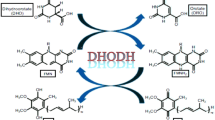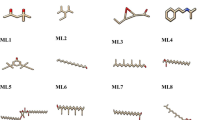Abstract
Non-Hodgkin lymphoma (NHL) is one of the most common cancer types. Deregulated signaling pathways can trigger certain NHL subtypes, including Diffuse Large B-cell lymphoma. NF-ĸB signaling pathway, which is responsible for the proliferation, growth, and survival of cells, has an essential role in lymphoma development. Although different signals control NF-ĸB activation in various lymphoid malignancies, the characteristic one is the CARD11-BCL10-MALT1 (CBM) complex. The CBM complex is responsible for the initiation of adaptive immune response. Our study is focused on the molecular docking of ten polyphenols as potential CARD11-BCL10-MALT1 complex inhibitors, essentially through MALT1 inhibition. Molecular docking was performed by Auto Dock Tools and AutoDock Vina tool, while SwissADME was used for drug-likeness and absorption, distribution, metabolism, excretion, and toxicity (ADMET) analysis of the ligands. Out of 66 ligands that were used in this study, we selected and visualized five. Selection criteria were based on the binding energy score and position of the ligands on the used protein. 2D and 3D visualizations showed interactions of ligands with the protein. Five ligands are considered potential inhibitors of MALT1, thus affecting NF-ĸB signaling pathway. However, additional in vivo and in vitro studies are required to confirm their mechanism of inhibition.





Similar content being viewed by others
Data availability
Data analyzed in this study have been either provided or are publicly available in the referred databases.
References
Sleire L, Førde HE, Netland IA, Leiss L, Skeie BS, Enger PØ. Drug repurposing in cancer. Pharmacol Res. 2017;124:74–91. https://doi.org/10.1016/j.phrs.2017.07.013.
Housman G, Byler S, Heerboth S, Lapinska K, Longacre M, Snyder N, et al. Drug resistance in cancer: an overview. Cancers. 2014;6(3):1769–92. https://doi.org/10.3390/cancers6031769.
Padala SA, Kallam A. Diffuse large B-cell lymphoma. In: StatPearls. Treasure Island: StatPearls Publishing; 2023 [cited 2023 Jun 15]. Available from: http://www.ncbi.nlm.nih.gov/books/NBK557796/.
Carreras J, Hiraiwa S, Kikuti YY, Miyaoka M, Tomita S, Ikoma H, et al. Artificial neural networks predicted the overall survival and molecular subtypes of diffuse large B-cell lymphoma using a pancancer immune-oncology panel. Cancers. 2021;13(24):6384. https://doi.org/10.3390/cancers13246384.
Carreras J, Roncador G, Hamoudi R. Artificial intelligence predicted overall survival and classified mature B-cell neoplasms based on immuno-oncology and immune checkpoint panels. Cancers. 2022;14(21):5318. https://doi.org/10.3390/cancers14215318.
Campo E, Jaffe ES, Cook JR, Quintanilla-Martinez L, Swerdlow SH, Anderson KC, et al. The international consensus classification of mature lymphoid neoplasms: a report from the clinical advisory committee. Blood. 2022;140(11):1229–53. https://doi.org/10.1182/blood.2022015851.
Jamil A, Mukkamalla SKR. Lymphoma. In: StatPearls. Treasure Island: StatPearls Publishing, 2022 [cited 2022 Mar 17]. Available from: http://www.ncbi.nlm.nih.gov/books/NBK560826/.
Lewis WD, Lilly S, Jones KL. Lymphoma: diagnosis and treatment. Am Fam Physician. 2020;101(1):34–41.
National Cancer Institute. Non-Hodgkin lymphoma—cancer stat facts. SEER. 18 March 2022. https://seer.cancer.gov/statfacts/html/nhl.html.
Bezombes C, Pérez-Galán P. Immunotherapies in non-Hodgkin’s lymphoma. Cancers. 2021;13(14):3625. https://doi.org/10.3390/cancers13143625.
Sheikh S, Migliorini D, Lang N. CAR T-based therapies in lymphoma: a review of current practice and perspectives. Biomedicines. 2022;10(8):1960. https://doi.org/10.3390/biomedicines10081960.
Sun R, Yu Q, Young KH. Critically dysregulated signaling pathways and clinical utility of the pathway biomarkers in lymphoid malignancies. Chronic Dis Transl Med. 2018;4(1):29–44. https://doi.org/10.1016/j.cdtm.2018.02.001.
Xu W, Berning P, Lenz G. Targeting B-cell receptor and PI3K signaling in diffuse large B-cell lymphoma. Blood. 2021;138(13):1110–9. https://doi.org/10.1182/blood.2020006784.
Gu Y, Mohammad IS, Liu Z. Overview of the STAT-3 signaling pathway in cancer and the development of specific inhibitors. Oncol Lett. 2020;19(4):2585–94. https://doi.org/10.3892/ol.2020.11394.
Young RM, Shaffer AL, Phelan JD, Staudt LM. B-cell receptor signaling in diffuse large B-cell lymphoma. Semin Hematol. 2015;52(2):77–85. https://doi.org/10.1053/j.seminhematol.2015.01.008.
Staudt LM. Oncogenic activation of NF-kappaB. Cold Spring Harb Perspect Biol. 2010;2(6):a000109. https://doi.org/10.1101/cshperspect.a000109.
Kennedy R, Klein U. Aberrant activation of NF-κB signalling in aggressive lymphoid malignancies. Cells. 2018;7(11):189. https://doi.org/10.3390/cells7110189.
Chang TP, Vancurova I. NFκB function and regulation in cutaneous T-cell lymphoma. Am J Cancer Res. 2013;3(5):433–45.
Balaji S, Ahmed M, Lorence E, Yan F, Nomie K, Wang M. NF-κB signaling and its relevance to the treatment of mantle cell lymphoma. J Hematol OncolJ Hematol Oncol. 2018;11(1):83. https://doi.org/10.1186/s13045-018-0621-5.
Roy P, Sarkar UA, Basak S. The NF-κB activating pathways in multiple myeloma. Biomedicines. 2018;6(2):59. https://doi.org/10.3390/biomedicines6020059.
Grondona P, Bucher P, Schulze-Osthoff K, Hailfinger S, Schmitt A. NF-κB activation in lymphoid malignancies: genetics, signaling, and targeted therapy. Biomedicines. 2018;6(2):38. https://doi.org/10.3390/biomedicines6020038.
Liu T, Zhang L, Joo D, Sun SC. NF-κB signaling in inflammation. Signal Transduct Target Ther. 2017;2:17023. https://doi.org/10.1038/sigtrans.2017.23.
Yu H, Lin L, Zhang Z, Zhang H, Hu H. Targeting NF-κB pathway for the therapy of diseases: mechanism and clinical study. Signal Transduct Target Ther. 2020;5(1):209. https://doi.org/10.1038/s41392-020-00312-6.
Sun SC. Non-canonical NF-κB signaling pathway. Cell Res. 2011;21(1):71–85. https://doi.org/10.1038/cr.2010.177.
Schlauderer F, Seeholzer T, Desfosses A, Gehring T, Strauss M, Hopfner KP, et al. Molecular architecture and regulation of BCL10-MALT1 filaments. Nat Commun. 2018;9(1):4041. https://doi.org/10.1038/s41467-018-06573-8.
Meininger I, Krappmann D. Lymphocyte signaling and activation by the CARMA1-BCL10-MALT1 signalosome. Biol Chem. 2016;397(12):1315–33. https://doi.org/10.1515/hsz-2016-0216.
Sun L, Deng L, Ea CK, Xia ZP, Chen ZJ. The TRAF6 ubiquitin ligase and TAK1 kinase mediate IKK activation by BCL10 and MALT1 in T lymphocytes. Mol Cell. 2004;14(3):289–301. https://doi.org/10.1016/s1097-2765(04)00236-9.
Israël L, Bornancin F. Ways and waves of MALT1 paracaspase activation. Cell Mol Immunol. 2018;15(1):8–11. https://doi.org/10.1038/cmi.2017.77.
Ginster S, Bardet M, Unterreiner A, Malinverni C, Renner F, Lam S, et al. Two antagonistic MALT1 auto-cleavage mechanisms reveal a role for TRAF6 to unleash MALT1 activation. PLoS ONE. 2017;12(1):e0169026. https://doi.org/10.1371/journal.pone.0169026.
Baens M, Bonsignore L, Somers R, Vanderheydt C, Weeks SD, Gunnarsson J, et al. MALT1 auto-proteolysis is essential for NF-κB-dependent gene transcription in activated lymphocytes. PLoS ONE. 2014;9(8):e103774. https://doi.org/10.1371/journal.pone.0103774.
Jaworski M, Thome M. The paracaspase MALT1: biological function and potential for therapeutic inhibition. Cell Mol Life Sci. 2016;73(3):459–73. https://doi.org/10.1007/s00018-015-2059-z.
Izuegbuna OO. Polyphenols: chemoprevention and therapeutic potentials in hematological malignancies. Front Nutr. 2022;26(9):1008893. https://doi.org/10.3389/fnut.2022.1008893.
Chauhan A, Islam AU, Prakash H, Singh S. Phytochemicals targeting NF-κB signaling: potential anti-cancer interventions. J Pharm Anal. 2022;12(3):394–405. https://doi.org/10.1016/j.jpha.2021.07.002.
Madhavi Sastry G, Adzhigirey M, Day T, Annabhimoju R, Sherman W. Protein and ligand preparation: parameters, protocols, and influence on virtual screening enrichments. J Comput Aided Mol Des. 2013;27(3):221–34. https://doi.org/10.1007/s10822-013-9644-8.
Daina A, Michielin O, Zoete V. SwissADME: a free web tool to evaluate pharmacokinetics, drug-likeness and medicinal chemistry friendliness of small molecules. Sci Rep. 2017;7(1):42717. https://doi.org/10.1038/srep42717.
Karami TK, Hailu S, Feng S, Graham R, Gukasyan HJ. Eyes on lipinski’s rule of five: a new, “rule of thumb” for physicochemical design space of ophthalmic drugs. J Ocul Pharmacol Ther. 2022;38(1):43–55. https://doi.org/10.1089/jop.2021.0069.
Ghose AK, Viswanadhan VN, Wendoloski JJ. A knowledge-based approach in designing combinatorial or medicinal chemistry libraries for drug discovery 1: a qualitative and quantitative characterization of known drug databases. J Comb Chem. 1999;1(1):55–68. https://doi.org/10.1021/cc9800071.
Veber DF, Johnson SR, Cheng HY, Smith BR, Ward KW, Kopple KD. Molecular properties that influence the oral bioavailability of drug candidates. J Med Chem. 2002;45(12):2615–23. https://doi.org/10.1021/jm020017n.
Egan WJ, Merz KM, Baldwin JJ. Prediction of drug absorption using multivariate statistics. J Med Chem. 2000;43(21):3867–77. https://doi.org/10.1021/jm000292e.
Yadav R, Imran M, Dhamija P, Chaurasia DK, Handu S. Virtual screening, ADMET prediction and dynamics simulation of potential compounds targeting the main protease of SARS-CoV-2. J Biomol Struct Dyn. 2021;39(17):6617–32. https://doi.org/10.1080/07391102.2020.1796812.
Grogan S, Preuss CV. Pharmacokinetics. In: StatPearls. Treasure Island: StatPearls Publishing; 2023 [cited 2023 Jun 11]. Available from: http://www.ncbi.nlm.nih.gov/books/NBK557744/.
Samuels ER, Sevrioukova I. Inhibition of human CYP3A4 by rationally designed ritonavir-like compounds: impact and interplay of the side group functionalities. Mol Pharm. 2018;15(1):279–88. https://doi.org/10.1021/acs.molpharmaceut.7b00957.
Fontán L, Qiao Q, Hatcher JM, Casalena G, Us I, Teater M, et al. Specific covalent inhibition of MALT1 paracaspase suppresses B cell lymphoma growth. J Clin Invest. 2018;128(10):4397–412. https://doi.org/10.1172/JCI99436.
Ferch U, Kloo B, Gewies A, Pfänder V, Düwel M, Peschel C, et al. Inhibition of MALT1 protease activity is selectively toxic for activated B cell–like diffuse large B cell lymphoma cells. J Exp Med. 2009;206(11):2313–20. https://doi.org/10.1084/jem.20091167.
Shukla S, Kanwal R, Shankar E, Datt M, Chance MR, Fu P, et al. Apigenin blocks IKKα activation and suppresses prostate cancer progression. Oncotarget. 2015;6(31):31216–32. https://doi.org/10.18632/oncotarget.5157.
Wu DG, Yu P, Li JW, Jiang P, Sun J, Wang HZ, et al. Apigenin potentiates the growth inhibitory effects by IKK-β-mediated NF-κB activation in pancreatic cancer cells. Toxicol Lett. 2014;224(1):157–64. https://doi.org/10.1016/j.toxlet.2013.10.007.
Liao SC, Hsu HW, Chuang KL, Huang ZY, Lin KT, Hsu WH, et al. Using the pleiotropic characteristics of curcumin to validate the potential application of a novel gene expression screening platform. Nutrients. 2019;11(6):1397. https://doi.org/10.3390/nu11061397.
Olivera A, Moore TW, Hu F, Brown AP, Sun A, Liotta DC, et al. Inhibition of the NF-κB signaling pathway by the curcumin analog, 3,5-Bis(2-pyridinylmethylidene)-4-piperidone (EF31): anti-inflammatory and anti-cancer properties. Int Immunopharmacol. 2012;12(2):368–77. https://doi.org/10.1016/j.intimp.2011.12.009.
Ji G, Zhang Y, Yang Q, Cheng S, Hao J, Zhao X, et al. Genistein suppresses LPS-induced inflammatory response through inhibiting NF-κB following AMP kinase activation in RAW 264.7 macrophages. PLoS ONE. 2012;7(12):e53101. https://doi.org/10.1371/journal.pone.0053101.
Funding
The authors declare that no funds or other support were received during the preparation of this manuscript.
Author information
Authors and Affiliations
Contributions
All authors contributed to the study conception and design. Material preparation, data collection, and analysis were performed by Abas Sezer. Writing, review, and editing were performed by LM, while conceptualization and supervision were performed by BA. The first draft of the manuscript was written by AS and all authors commented on previous versions of the manuscript. All authors read and approved the final manuscript.
Corresponding author
Ethics declarations
Competing interest
The authors have no relevant financial or non-financial interests to disclose.
Additional information
Publisher's Note
Springer Nature remains neutral with regard to jurisdictional claims in published maps and institutional affiliations.
Supplementary Information
Below is the link to the electronic supplementary material.
Rights and permissions
Springer Nature or its licensor (e.g. a society or other partner) holds exclusive rights to this article under a publishing agreement with the author(s) or other rightsholder(s); author self-archiving of the accepted manuscript version of this article is solely governed by the terms of such publishing agreement and applicable law.
About this article
Cite this article
Sezer, A., Mahmutović, L. & Akçeşme, B. In silico study of polyphenols as potential inhibitors of MALT1 protein in non-Hodgkin lymphoma. Med Oncol 41, 37 (2024). https://doi.org/10.1007/s12032-023-02261-w
Received:
Accepted:
Published:
DOI: https://doi.org/10.1007/s12032-023-02261-w




